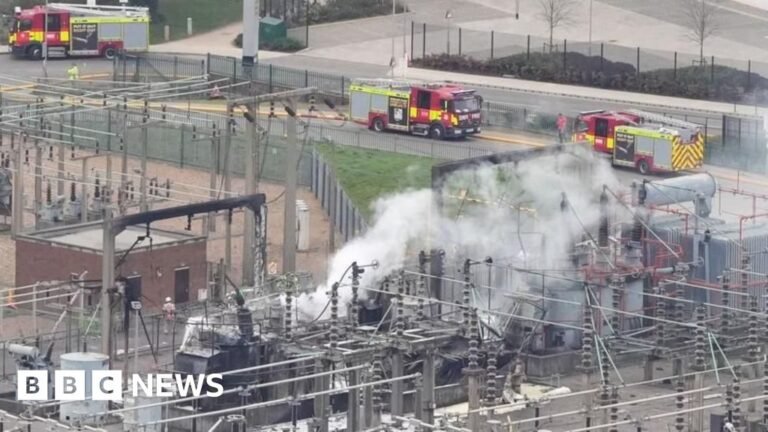Faarea Masud
Business reporter, BBC News
PA Media
Issues at an electrical substation which caused a fire that resulted in Heathrow Airport closing were first detected seven years ago but not fixed, a report has found.
The National Energy System Operator (NESO) said moisture entering electrical components at the North Hyde substation caused the blaze at the site that supplies the UK’s biggest airport with power.
It revealed an elevated moisture reading had been first detected in July 2018, but that “mitigating actions appropriate to its severity were not implemented”, with basic maintenance cancelled.
Heathrow shut down the following day as a result of the power cut, which led to thousands of cancelled flights and stranded passengers.
Neso’s report said previously that the the power outage affected 66,919 domestic and commercial customers, including Heathrow Airport. Around 270,000 journeys were affected.
Its report said the fire “was most likely caused by moisture entering the bushing causing a short circuit. The electricity likely then “arced” (causing sparks) which combined with air and heat to ignite the oil, resulting in a fire”.
Bushing is insulating material used around electrical parts for safe operation of equipment.
In response to the report, Heathrow Airport said a “combination of outdated regulation, inadequate safety mechanisms, and National Grid’s failure to maintain its infrastructure” that led to this “catastrophic power outage”.
“We expect National Grid to be carefully considering what steps they can take to ensure this isn’t repeated,” it added.
Neso said that “it was not known to the energy companies” that the loss of one of the electrical supply points – of which Heathrow has three – would result in a power outage to some of the airport’s critical systems.
“The review also found that energy network operators are not generally aware whether customers connected to their networks are Critical National Infrastructure,” it said.
The power failure resulting in the closer of Heathrow raised wider questions about the UK’s energy resilience.
Energy Secretary Ed Miliband said the report was “deeply concerning” as risks “were not addressed by the National Grid”.
He added that Ofgem, the energy watchdog, had opened an official enforcement investigation “to consider any possible licence breaches” relating to the development and maintenance of its substation in North Hyde, which was built in the 1960s.
“There are wider lessons to be learned from this incident,” he added.
Akshay Kaul, director general for Infrastructure at Ofgem, said it expected energy companies to “properly maintain their equipment and networks to prevent events like this happening”.
“Where there is evidence that they have not, we will take action and hold companies fully to account,” he added.
National Grid said it had a “comprehensive asset inspection and maintenance programme in place, and we have taken further action since the fire”, which included “re-testing the resilience of substations that serve strategic infrastructure”.
While power was restored to Heathrow by 06:25 on 21 March using circuits from another nearby substation, the flow of electricity to all four of Heathrow’s passenger terminals was not restored until 10:56.
Flights did not resume until after 18:00 that day, once safety checks were completed. Planes were able to land and take off through the night to enable Heathrow to get back up to full capacity.
Nigel Wicking, chief executive of Heathrow Airline Operators’ Committee, told the BBC that Heathrow’s closure cost airlines between £80m-£100m.

